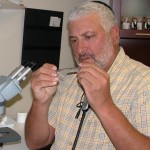
Leonard Bielory
Pollen season is here!
There’s no mistaking it as some allergy sufferers in New Jersey and in the Northeast are already put on notice with teary, itchy eyes already a part of their daily existence. These symptoms are expected to be more in evidence in the next few weeks as tree pollen levels begin to soar.
Leonard Bielory, M.D., a specialist in allergy and immunology with the Rutgers Center of Environmental Prediction at the School of Environmental and Biological Sciences and attending physician at Robert Wood Johnson University Hospital, thinks that the increased precipitation from Superstorm Sandy plus the snowfall from the last Nor’easter promises a robust allergy season.
“The precipitation that originally suppressed pollen release will now ‘water’ it,” says Bielory. The first airborne tree pollen has been measured in recent days and while the count is still low, some allergy sufferers are showing comparatively severe symptoms, he adds.
 Although pollen counts at the start of the season are low, relatively small amounts can cause strong allergic symptoms. Tree pollen counts between 0-14 (low) pollen grains per cubic meter of air are enough to cause symptoms such as sneezing, itchy and runny nose, and runny eyes in adult allergy sufferers and somewhat less so in children. In some patients who have had the flu or other viral affecting the upper respiratory tract, “the sensitivity of the nose and eyes may have been increased through previous infections like winter colds or flu,” adds Bielory.
Although pollen counts at the start of the season are low, relatively small amounts can cause strong allergic symptoms. Tree pollen counts between 0-14 (low) pollen grains per cubic meter of air are enough to cause symptoms such as sneezing, itchy and runny nose, and runny eyes in adult allergy sufferers and somewhat less so in children. In some patients who have had the flu or other viral affecting the upper respiratory tract, “the sensitivity of the nose and eyes may have been increased through previous infections like winter colds or flu,” adds Bielory.
He and colleagues have been engaged in a long-term study of the effects of climate change and allergic airway disease. They expect more tree pollen than ever to be released this spring and the reaction to the early pollen to continue to be unusually strong.
“We have been developing models in order to forecast pollen production and its impact on allergies,” he says. Among the most recent and unexpected findings that his research group has validated is the link to precipitation from the previous year. “We can also expect that the tree pollen season to be present not for a longer period of time, but in heavier concentrations.”
Pollen allergy sufferers who would like to discover more about the connection between their individual symptoms and the pollen count in their area are invited to visit NYNJpollen.com. They might also consider using the electronic pollen diary from iTunes or iPollenCount to record and graph their symptoms and send these to their doctors.

